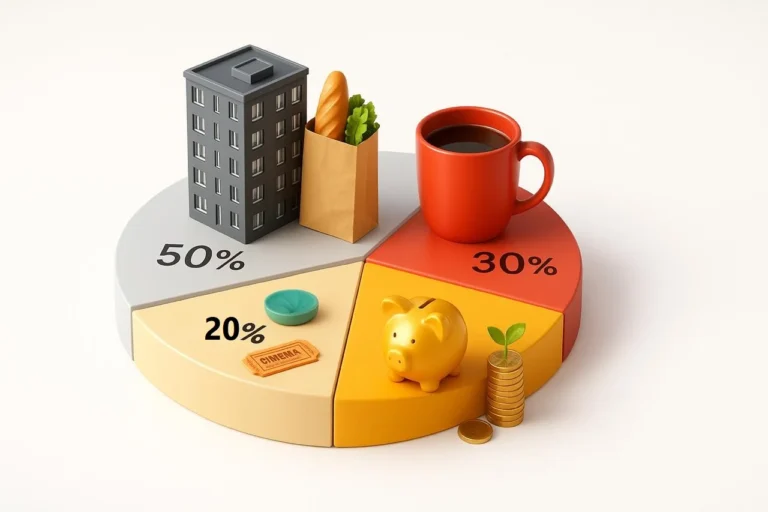Originally Published: February 2025 | Last Updated: August 2025
The Latte Factor & The Secret to Wealth
Imagine this: Every morning, you grab a cup of coffee from your favorite cafe. It’s just $5, nothing major, right? But let’s do some math. That’s $150 a month and $1,800 a year. Now, imagine investing that money instead. With compound interest, it could turn into thousands over time.

Now, what if I told you that your daily habits—like canceled plans, minor expenses, and even your kid’s pocket money—could be secretly building your future wealth? Let’s dive into some smart, simple, and fun ways to understand how Small Savings making Big Impact without feeling like you are sacrificing anything!
This idea is known as The Latte Factor, a concept made famous by financial expert David Bach. It is not about cutting out everything you enjoy; it is about realizing that small, seemingly insignificant savings can create a massive impact over time.
1️⃣ The “Already Spent” Trick: Turn Canceled Plans into Savings
Ever planned a dinner out or a movie night, only to have it canceled at the last minute? Instead of letting that money get absorbed into your everyday spending, treat it like it is already spent—but on your future self. (this is the Small Savings making Big Impact)
Example:
You were about to spend $30 on dinner, but plans fell through. Instead of spending that money on something else, transfer it to a savings account or hide it in a separate jar.
Why It Works:
• You’ve already mentally accounted for that money being gone.
• It makes saving feel effortless.
• Over time, these canceled plans add up to a solid emergency fund or investment.
Action Step:
Next time a plan gets canceled, transfer that money into a “No-Spend Savings” account or a physical savings jar. Watch how quickly your savings grow!
2️⃣ The “Almost Bought It” Piggy Bank: A Hack for Smart Spending (to understand Small Savings making Big Impact)
Have you ever been this close to buying something—a new pair of sneakers, a trendy gadget, or a fancy dessert—but changed your mind at the last second? Instead of forgetting about that money, save it instead.
Example:
You were about to buy a $40 sweater, but you decided against it. Rather than letting that money disappear into your daily spending, transfer that exact amount to a savings account or jar.
Why It Works:
• It turns “not spending” into a rewarding habit.
• You still feel like you “spent” the money—but on something even better: your future wealth.
• Over time, these small amounts add up without requiring major lifestyle changes.
Action Step:
Start an “Almost Bought It” piggy bank and deposit money whenever you resist an unnecessary purchase. In a few months, you’ll be surprised at how much you’ve saved!

3️⃣ The Pocket Money Challenge: Teach Kids (and Yourself) the Power of Saving
If you give your kids pocket money, this is a golden opportunity to instill a lifelong savings habit. Instead of letting them spend it all, encourage them to save a small percentage each time.
Example:
Your child gets $10 in pocket money. Encourage them to save at least $2 in a jar or a bank account. Over time, they’ll develop the mindset that saving is just as important as spending.
Why It Works:
• It builds financial discipline from an early age.
• Your kids learn that small savings can lead to big rewards.
• You can even match their savings to keep them motivated!
Action Step:
Create a savings challenge with your kids! Set a goal—maybe a new toy or a fun outing—and show them how their savings grow over time. Bonus: Join the challenge yourself!
🧠 Bonus Tips to Supercharge Your Savings Journey
These are not just tips—they are practical Small Savings making Big Impact habits that can turn you from a passive spender into an active saver. Let’s dig in:
💡 1. Use the 24-Hour Rule Before Any Non-Essential Purchase
What’s the idea?
Before buying something you want (not need), wait 24 hours. This pause gives your brain time to process if it’s truly necessary.
Real-life example:
You see a sleek new smartwatch for $200. It looks amazing. But after 24 hours, you realize your old one works just fine—and you’ve just saved yourself $200.
Takeaway:
Impulse spending is like junk food—satisfying in the moment, regrettable later.
Action Step for Small Savings making Big Impact:
Add a “wishlist” to your phone. If it still feels important after a day, revisit it. 8/10 times, you’ll let it go.
💡 2. Automate a Tiny Transfer Every Week
How?
Set your bank to automatically transfer a small amount (even ₹100 or $2) weekly to a separate savings account.
Why it works:
Out of sight, out of mind—but into savings!
Takeaway:
Small automation beats large intentions. Consistency is everything.
Action Step for Small Savings making Big Impact:
Use apps like Digit, Qapital, or just set a standing instruction on your bank app.
💡 3. Join a Zero-Based Budget Challenge
What is it?
Every rupee or dollar you earn is assigned a job—spending, saving, or investing—so nothing is “leftover” to accidentally spend.
Why it’s gold:
It brings total control and purpose to your money.
Action Step for Small Savings making Big Impact:
Try budgeting apps like YNAB (You Need A Budget) or PocketGuard.

Frequently Asked Questions (FAQs)
(How Small Savings making Big Impact )
❓Q1: How can I start the Round-Up Savings method if my bank doesn’t support it?
Answer:
If your bank doesn’t offer round-up features, go manual. After every purchase, check your total. Round it up in your mind and transfer the extra to a “spare change” account weekly. It’s a small effort with big results.
❓Q2: What is the No-Spend Challenge and how do I begin one?
Answer:
Pick a time frame—weekend, week, or month—where you only spend on essentials. Track it in a journal or spreadsheet. Reflect at the end on how much you saved and learned. Tip: Involve a friend for accountability.
❓Q3: Are subscription detoxes really effective for saving money?
Answer:
Absolutely. Many people pay for services they rarely use—gym memberships, streaming, apps. Review your subscriptions monthly. Cancel one, and you might save hundreds annually. That’s guilt-free money back in your pocket!
❓Q4: How do I motivate myself to save consistently when money is already tight?
Answer:
Start small. Even saving ₹10–₹20 daily adds up. Use visual motivators (like tracking progress on a chart or using a labeled jar). Also, link savings to emotional goals—like “vacation fund” or “freedom fund.” Motivation grows when you name your savings purpose.
“Master Your Money _ Empower Your Life”
A Good Read: Black Friday Shopping Tips for Beginners: The Ultimate Financial Fitness Guide
Your Small Savings making Big Impact: Checklist
Want to make small savings a habit? Use this quick checklist to track your progress:
✅ Set up a “No-Spend Savings” jar for canceled plans.
✅ Create an “Almost Bought It” account for resisted purchases.
✅ Encourage kids (or yourself!) to save a percentage of pocket money.
✅ Challenge yourself to save just $1 a day—watch it grow!
✅ Automate small weekly transfers to your savings account.
How many of these habits can you start this week? Comment below and let’s track our savings together!
Conclusion: Small Savings making Big Impact
Saving money isn’t about cutting out all fun—it’s about making small, smart choices that add up over time. By applying these simple tricks, you’ll create a financial cushion without even noticing the difference in your lifestyle.
Remember: Wealth isn’t built overnight—it’s built by consistent, tiny efforts that compound into something huge. So start today, one small saving at a time!
as you Enjoyed Small Savings making Big Impact then you will Love below articles;
How to Save Money Fast for Kids : 6 Strategies & 3 bonus tip
Call to Action (CTA): Join the Conversation!
Did any of these savings tips resonate with you? Have you tried similar tricks before? Share your experiences in the comments!
Also, don’t forget to subscribe to TheFitFinance for more fun, practical, and motivational finance tips! Let’s build our financial future together—one small step at a time.







